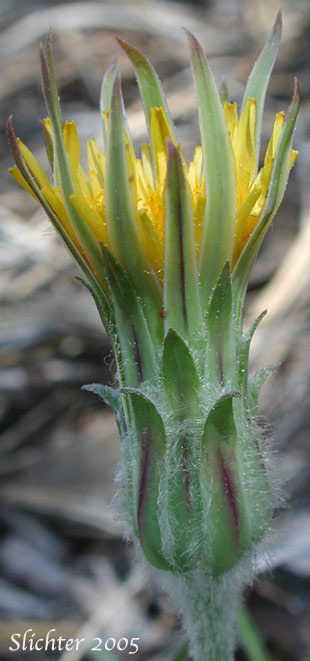
 The
photo at right shows a key identifying characteristic of spear-leaf agoseris.
The upper end of the achene or seed is squared off and the narrow beak which
is plumed (or parachute-like) at its end. Photographed at Catherine Creek,
central Columbia River Gorge..........June 3, 2006.
The
photo at right shows a key identifying characteristic of spear-leaf agoseris.
The upper end of the achene or seed is squared off and the narrow beak which
is plumed (or parachute-like) at its end. Photographed at Catherine Creek,
central Columbia River Gorge..........June 3, 2006.
Spear-leaf agoseris is a perennial wildflower with one to several erect, leafless scapes arising 15-60 cm high from a cluster of basal leaves atop a taproot. Plants typically begin with a covering of soft, shaggy, tangled hairs but eventually become glabrous with age, especially above. The leaves measure 8-20 cm long and are narrowly oblong, lanceolate or elliptical in outline and gradually tapering to a narrow tip at both ends. The margins are deeply lobed with the lobes generally long and linear with the lower ones spreading and the upper ones directed backwards.
A single flower head consisting entirely of ray flowers may be found atop each scape. The heads tend to be narrower than those found in the similar large-flowered agoseris. The involucre ranges from 2.5-5 cm long in fruit. The outer involucral bracts are shorter and lance-oblong in outline while the inner bracts are longer and broad below tapering gradually to the long linear upper portion. The rays are typically yellow, although they often dry to a pinkish color. The achenes are cylindrical, measure 5-6 mm long, and are truncate at the apex, with the beak about 3-4 times longer than the body of the achene.
Spear-leaf agoseris may typically be found in dry, open woods.
Spear-leaf agoseris may be found along the eastern edge of the Cascade Mts. from Chelan County in Washington south to California and Nevada and east through Oregon and Washington to southwestern Idaho.
In the Columbia River Gorge, it may be found between the elevations of 400'-2500' from the White Salmon River east to near the Klickitat River.